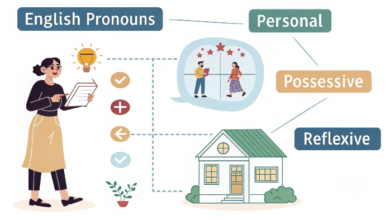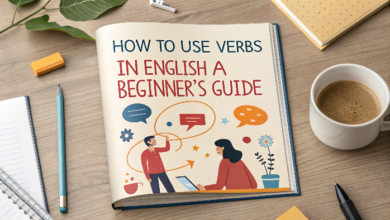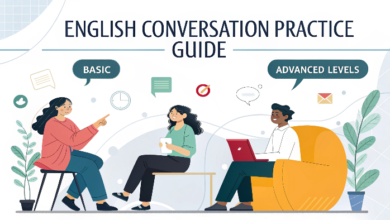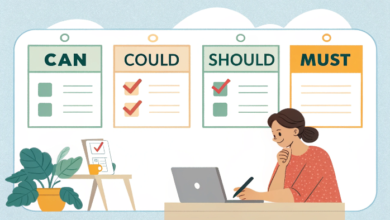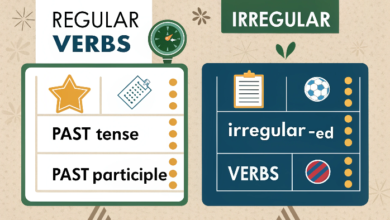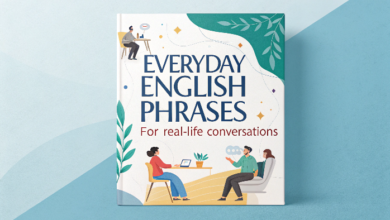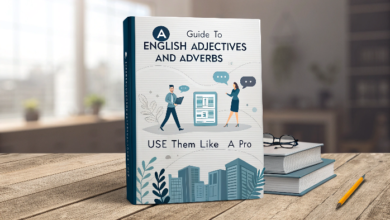The Ultimate Guide to English Verb Tenses: Mastering the Basics

The Ultimate Guide to English Verb Tenses: Mastering the Basics
Understanding verb tenses is crucial to mastering English grammar. Whether you’re writing or speaking, knowing how to use verb tenses correctly will help you communicate clearly and effectively. In this guide, we’ll cover the basics of English verb tenses,
provide examples, and help you learn when and how to use them in everyday conversation and writing. Whether you’re a beginner or looking to refine your skills, this guide will give you the tools to succeed.
What Are Verb Tenses in English
Verb tenses indicate the time when an action or event occurs. In English, verb tenses are used to convey whether an action happens in the past, present, or future. Understanding these tenses is essential for expressing actions at different times.
Key Types of Verb Tenses
Past Tense: Describes actions that happened in the past.
Present Tense: Describes actions happening right now or regularly.
Future Tense: Describes actions that will happen in the future.
Each of these categories has four aspects: simple, continuous (progressive), perfect, and perfect continuous.
The Simple Tenses
a. Simple Present Tense
Used to describe regular actions, facts, habits, or general truths.
Structure: Subject + base verb (for plural/nouns) / Subject + verb + ‘s’ (for singular)
I study English every day.
She reads books on weekends.
b. Simple Past Tense
Used to describe actions that were completed at a specific point in the past.
Structure: Subject + verb (in past form)
Example:
They watched a movie last night.
He finished his homework yesterday.
c. Simple Future Tense
Used to describe actions that will happen in the future.
Structure: Subject + ‘will’ + base verb
I will go to the market tomorrow.
She will study for the exam next week.
The Continuous (Progressive) Tenses
a. Present Continuous Tense
Used to describe actions happening right now or actions that are temporary.
Structure: Subject + ‘am/are/is’ + verb-ing
Example:
I am studying English right now.
They are playing soccer at the moment.
b. Past Continuous Tense
Describes actions that were ongoing in the past.
Structure: Subject + ‘was/were’ + verb-ing
Example:
I was reading when the phone rang.
They were walking to the park at 5 PM yesterday.
c. Future Continuous Tense
Describes actions that will be ongoing in the future.
Structure: Subject + ‘will be’ + verb-ing
Example:
I will be traveling next week.
They will be studying for exams in the evening.
The Perfect Tenses
a. Present Perfect Tense
Used to describe actions that occurred at an unspecified time before now and are still relevant.
Structure: Subject + ‘has/have’ + past participle
Example:
I have finished my homework.
She has traveled to several countries.
b. Past Perfect Tense
Describes actions that were completed before another action in the past.
Structure: Subject + ‘had’ + past participle
Example:
He had left before I arrived.
They had finished their work when the meeting started.
c. Future Perfect Tense
Describes actions that will be completed by a certain point in the future.
Structure: Subject + ‘will have’ + past participle
Example:
I will have graduated by next year.
They will have completed the project by Friday.
The Perfect Continuous Tenses
a. Present Perfect Continuous Tense
Used to describe actions that started in the past and are still continuing in the present.
Structure: Subject + ‘has/have’ + ‘been’ + verb-ing
Example:
I have been studying for two hours.
She has been working at this company since 2010.
b. Past Perfect Continuous Tense
Describes actions that were ongoing in the past before another past action occurred.
Structure: Subject + ‘had’ + ‘been’ + verb-ing
Example:
They had been waiting for an hour before the train arrived.
He had been working all day when his friends called.
c. Future Perfect Continuous Tense
Describes actions that will continue up until a certain point in the future.
Structure: Subject + ‘will have been’ + verb-ing
Example:
I will have been studying for three hours by the time you arrive.
She will have been working at the company for five years by the end of the year.
For more, go to the next page

